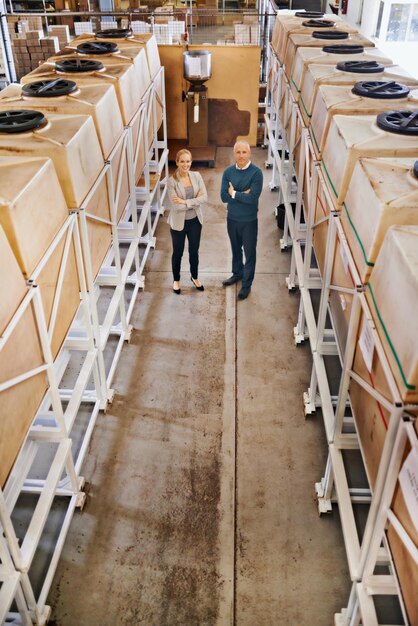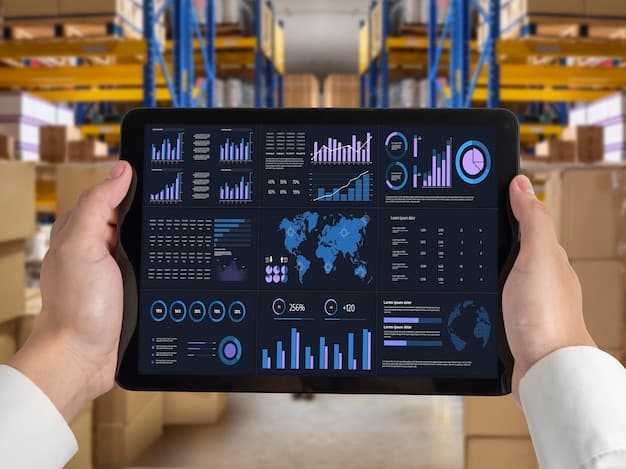Supply Chain Disruptions: How Manufacturing Can Adapt

Supply chain disruptions continue to significantly impact the manufacturing sector, leading to increased costs, production delays, and the need for businesses to adopt more resilient and adaptive strategies.
The manufacturing sector is facing unprecedented challenges due to ongoing supply chain disruptions. These disruptions impact everything from raw material availability to delivery times, forcing manufacturers to rethink their strategies.
Understanding the Current State of Supply Chain Disruptions
Supply chain disruptions have become a persistent reality for the manufacturing sector. A combination of factors, including global events, geopolitical tensions, and increased demand variability, have created a volatile environment that manufacturers must navigate effectively.
Key Factors Contributing to Disruptions
Several key factors are contributing to the ongoing supply chain disruptions affecting manufacturing. Understanding these factors is crucial for developing effective mitigation strategies.
One primary driver is the lingering impact of the pandemic, which exposed vulnerabilities in global supply chains and exacerbated existing inefficiencies.
Geopolitical factors, such as trade tensions and political instability in key regions, further complicate the landscape, creating uncertainty and potential bottlenecks.
- Increased Demand Volatility: Fluctuations in consumer demand patterns are making it difficult for manufacturers to accurately forecast and plan production.
- Logistics Bottlenecks: Congestion at ports, shortages of shipping containers, and rising transportation costs are delaying shipments and increasing lead times.
- Raw Material Shortages: Scarcity of key raw materials and components is impacting production capacity and driving up input costs.

These factors highlight the need for manufacturers to adopt more resilient and agile supply chain strategies that can withstand disruptions and ensure business continuity. Building stronger relationships with suppliers, diversifying sourcing options, and investing in technology solutions are essential steps in navigating this complex environment.
The Impact on Manufacturing Operations
The impact of supply chain disruptions on manufacturing operations is multifaceted, affecting production schedules, costs, and overall efficiency. Manufacturers are experiencing significant operational challenges that require proactive and adaptive solutions.
Production Delays and Downtime
One of the most immediate impacts is production delays, which can lead to missed deadlines, reduced output, and dissatisfied customers. When critical components are unavailable, manufacturing lines come to a halt, resulting in costly downtime.
These delays can have a cascading effect, disrupting the entire production cycle and impacting downstream operations, such as distribution and fulfillment.
- Increased Lead Times: Longer lead times for materials and components are forcing manufacturers to extend production schedules and increase inventory levels.
- Higher Inventory Costs: Holding larger inventories to buffer against supply disruptions increases storage costs and ties up capital.
- Reduced Profit Margins: Rising input costs and production inefficiencies are squeezing profit margins and making it difficult for manufacturers to remain competitive.
Manufacturers must implement proactive measures to mitigate these operational impacts, such as improving demand forecasting, optimizing inventory management, and enhancing supply chain visibility. Investing in technologies like real-time tracking and predictive analytics can help manufacturers anticipate and respond to disruptions more effectively, ensuring smoother operations and minimizing costly downtime.
Strategies for Building a More Resilient Supply Chain
Building a resilient supply chain is essential for manufacturers to navigate the current disruptions and ensure long-term sustainability. This involves adopting a proactive and holistic approach that encompasses various aspects of supply chain management.
Diversifying the Supplier Base
One of the most effective strategies is to diversify the supplier base, reducing reliance on single sources and mitigating the risk of disruptions. By working with multiple suppliers, manufacturers can ensure a more stable supply of critical materials and components.
Diversification also fosters competition among suppliers, potentially leading to better pricing and improved service levels.
Manufacturers can improve their visibility into the supply chain by investing in technology solutions that provide real-time data on supplier performance, inventory levels, and potential risks.
- Nearshoring and Reshoring: Bringing production closer to home can reduce transportation costs and lead times, while improving responsiveness to local market demands.
- Strategic Partnerships: Collaborating closely with key suppliers can foster stronger relationships and improve communication, enabling quicker responses to disruptions.
- Contingency Planning: Developing detailed contingency plans that outline alternative sourcing options and production strategies can help manufacturers quickly adapt to unforeseen events.

By implementing these strategies, manufacturers can build more resilient and adaptable supply chains that are better equipped to withstand disruptions and maintain operational continuity. A diversified supplier base, enhanced visibility, and robust contingency plans are critical components of a resilient supply chain that can support long-term success.
Technology’s Role in Mitigating Disruptions
Technology plays a crucial role in mitigating supply chain disruptions by providing manufacturers with the tools and insights needed to improve visibility, optimize processes, and enhance decision-making. From real-time tracking to predictive analytics, technology is transforming supply chain management.
Real-Time Visibility and Tracking
Real-time visibility and tracking technologies enable manufacturers to monitor the movement of goods and materials throughout the supply chain, providing valuable insights into potential delays or bottlenecks.
These technologies use sensors, GPS, and other tracking devices to collect data on location, temperature, and other relevant parameters, providing a comprehensive view of the supply chain.
Advanced analytics tools enable manufacturers to identify patterns, predict future disruptions, and make data-driven decisions to mitigate their impact.
- Predictive Analytics: Using machine learning and statistical modeling to forecast demand, identify potential risks, and optimize inventory levels.
- Cloud-Based Platforms: Enabling collaboration and information sharing among all stakeholders in the supply chain, from suppliers to customers.
- Automation: Automating repetitive tasks, such as order processing and inventory management, to improve efficiency and reduce errors.
The Importance of Collaboration and Communication
Collaboration and communication are paramount in navigating supply chain disruptions. Manufacturers must foster strong relationships with suppliers, customers, and other stakeholders to ensure effective information sharing and coordinated responses to disruptions.
Building Strong Supplier Relationships
Building strong relationships with suppliers is essential for ensuring a reliable supply of materials and components. Regular communication, transparent information sharing, and collaborative problem-solving can help manufacturers and suppliers navigate challenges more effectively.
By working closely with key suppliers, manufacturers can gain valuable insights into their operations, identify potential risks, and develop joint mitigation strategies.
Open communication channels enable stakeholders to share information quickly and efficiently, facilitating coordinated responses to disruptions.
- Cross-Functional Teams: Establishing cross-functional teams that bring together representatives from different departments, such as procurement, logistics, and production, to address supply chain challenges collectively.
- Regular Meetings: Conducting regular meetings with suppliers, customers, and other stakeholders to discuss performance, identify potential issues, and develop action plans.
- Shared Platforms: Utilizing shared platforms and communication tools to facilitate information sharing and collaboration among all stakeholders.
Future Trends in Supply Chain Management
As the manufacturing sector continues to evolve, several key trends are shaping the future of supply chain management. Manufacturers that embrace these trends will be better positioned to navigate disruptions, improve efficiency, and drive innovation.
Adoption of Advanced Technologies
The adoption of advanced technologies, such as artificial intelligence, blockchain, and the Internet of Things, is accelerating, transforming various aspects of supply chain management. These technologies offer the potential to improve visibility, automate processes, and enhance decision-making.
Manufacturers are increasingly leveraging AI to optimize demand forecasting, predict potential disruptions, and automate supply chain operations.
Blockchain technology offers the potential to improve transparency and security in the supply chain, enabling manufacturers to track the movement of goods and materials from origin to destination with greater accuracy and confidence.
- Sustainability: Focusing on reducing the environmental impact of supply chain operations, from sourcing materials to transportation and distribution.
- Cybersecurity: Protecting supply chain data and systems from cyber threats, which are becoming increasingly sophisticated and prevalent.
- Talent Development: Investing in training and development programs to equip supply chain professionals with the skills and knowledge needed to navigate the complex challenges of the future.
| Key Point | Brief Description |
|---|---|
| ⚠️ Supplier Diversification | Reduces reliance on single sources, minimizing disruption risk. |
| 📊 Real-Time Visibility | Provides insights into goods movement, enabling proactive issue resolution. |
| 🤝 Collaboration | Enhances information sharing and coordinated responses. |
| 🤖 Tech Adoption | Improves processes with AI, blockchain, enhancing decision-making. |
Frequently Asked Questions
▼
The main causes include global events like pandemics, geopolitical tensions, natural disasters, increased demand volatility, and logistics bottlenecks at ports.
▼
Manufacturers can identify and onboard new suppliers, explore nearshoring or reshoring options, and establish strategic partnerships with key suppliers for better collaboration.
▼
Real-time visibility and tracking systems, predictive analytics, cloud-based platforms, and automation technologies significantly improve supply chain resilience and efficiency.
▼
Collaboration enhances information sharing among stakeholders, enabling quicker and more coordinated responses to disruptions, fostering stronger relationships and mutual support.
▼
Future trends include the adoption of AI, blockchain, IoT, a greater focus on sustainability, enhanced cybersecurity measures, and ongoing talent development in the field.
Conclusion
Navigating supply chain disruptions requires a multifaceted approach that combines strategic diversification, technological innovation, and strong collaborative relationships. By embracing these strategies, manufacturers can build more resilient and agile supply chains capable of weathering the challenges of an ever-changing global landscape.





